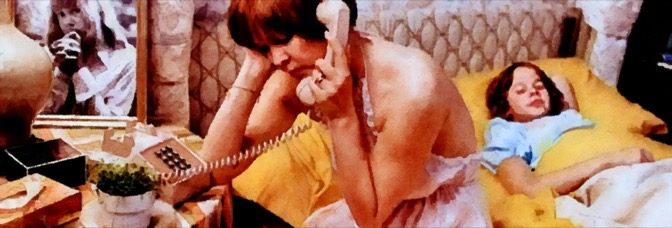Despite the title, The Exorcist is about pretty much everything except the actual exorcist. When he does appear, kicking off the third act, it’s kind of a stunt. There’s a lot of implied mythology in the film, without much connective tissue–but nothing ruling out connective tissue. Director Friedkin does a balancing act. The reveal moment of the exorcist, complete with foggy streets, is where Friedkin just gives in to the sensationalism.
It’s 1973, there’s a possession so real skeptical priest Jason Miller fights for it to be exorcized, things are about to get intense. There’s fog, isn’t there? And music. Friedkin’s sparing with music. He uses it to great effective earlier, less on the exorcist’s introduction.
The actual exorcism has excellent special effects and good acting. Friedkin’s direction is far more pragmatic than usual; unlike the rest of the film, he and editors Norman Gay and Evan A. Lottman don’t make any imaginative, affecting cuts. Cinematographer Owen Roizman is given the mundane task of insuring the frosty breath comes out. Previously, he’d been creating this warm, welcoming, terrifying Georgetown. It’s a step down.
Despite being entirely well-acted, none of The Exorcist’s actors particularly standout. Max von Sydow’s archeologist priest starts the film, digging up demonic relics. von Sydow just has to look scared or sick. It’s not much of a part. But Friedkin and the editors work their magic and make it through.
Then the film moves to Georgetown, where movie star Ellen Burstyn is filming an adaptation of William Peter Blatty’s best-selling novel, The Exorcist–just kidding, she’s in some mainstream hippie movie. She and daughter Linda Blair are living in a rental house, complete with servants and a full-time assistant (Kitty Winn). Everything’s going fine until something starts happening to Blair… and the doctors can’t figure out what.
At the same time, priest Jason Miller is confronting a crisis of faith while trying to care for his aging mother. Miller’s crisis doesn’t get much time, it’s just part of his ground situation.
The film cuts between Burstyn and Miller. They’re in the same neighborhood, their orbits moving closer and closer. Though not in any inevitable way, rather coincidental. Burstyn and Blair’s story, despite a deadbeat dad subplot, is a lot less intense than Miller’s. They have all the fun supporting cast members, including drunk movie director Jack MacGowran.
Friedkin and the editors seem to cut a little faster each time. Actors’ lines don’t finish in their scenes, but carried over to the next shot, the next scene. Simultaneously, Roizman’s photography is completely laid back. It’d be calming if the movie weren’t called The Exorcist and there weren’t occasional scary music and what are those weird noises in the attic?
After getting done with von Sydow and moving on to Blair, Burstyn, and Miller, the film keeps its character focus pretty well balanced. Until Blair gets less and less to do. She has to go to the doctor and we don’t find out until after it’s happened. That absence succeeds in hurrying things along, but not making Burstyn or Blair much more sympathetic. They’re sympathetic because they’re mother and daughter and Blair’s a cute kid, not because they’re particularly likable. Blatty’s script doesn’t do them any favors. He writes scenes for maximum effect, not character development.
Then Burstyn ends up losing time to Lee J. Cobb–as a police inspector–and Miller. Miller’s got a new church subplot, which eventually meets up with Cobb’s murder investigation one. It leads to an excellent scene, beautifully shot, edited, acted, but nothing for the story. During the second act, the film loses its sense of momentum. Cobb and Miller are too stone-faced; the film needs Burstyn’s growing dread, which it mostly skips, even going so far as to switch over to Miller to avoid showing Burstyn and Blair’s side.
Blair’s fine. She handles the part, which is considerable. She’s the film’s de facto subject. Everything revolves around her and she knows it. Mercedes McCambridge does even better, doing some of Blair’s character’s voice work.
Great acting from Cobb, Miller, and Burstyn when she’s got the material. Nice support from everyone else.
The Exorcist is often expertly and sublimely executed. But that strong execution mostly pauses for the third act. The epilogue is better though.

Leave a Reply